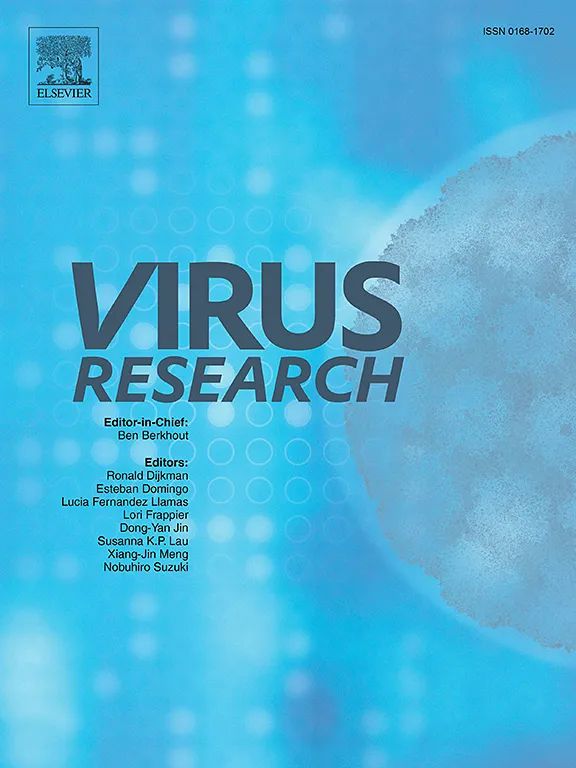Complex transmission of partiti-, ambi- and ourmiaviruses in the forest pathogen Heterobasidion parviporum
IF 2.5
4区 医学
Q3 VIROLOGY
引用次数: 0
Abstract
Utilizing Heterobasidion partitivirus 13 strain an1 (HetPV13-an1) and 15 strain pa1 (HetPV15-pa1) in co-infection is considered a potential biocontrol approach against Heterobasidion root and butt rot. Both partitiviruses mediate debilitating effects in most Heterobasidion host isolates and are generally transmitted efficiently between host strains. In this investigation, we conducted transmission experiments in the laboratory (in vitro) using several H. parviporum isolates to test whether using dual partitivirus infections is a more efficient way of transmitting viruses to new hosts compared to using single partitivirus infections, and whether co-occurring single-stranded RNA (ssRNA) viruses are co-transmitted during the process. The results showed that H. parviporum donors carrying both partitiviruses, HetPV13-an1 and HetPV15-pa1, transmitted HetPV15-pa1 more efficiently to recipients than the same donors infected with only HetPV15-pa1. In contrast, the transmission of HetPV13-an1 did not differ significantly between donors infected with both or only one partitivirus. Altogether, the transmission rates of HetPV13-an1 and HetPV15-pa1 were high on artificial media. Moreover, the transmission of the ssRNA viruses Heterobasidion ourmia-like virus 1(HetOlV1-pa7) and 4 (HetOlV4-an1) as well as Heterobasidion ambi-like virus 3 (HetAlV3-pa4) across different recipients were found to be variable. This study demonstrated for the first time the transmission of ambi- and ourmiaviruses between H. parviporum isolates in dual cultures and showed that H. parviporum mycelia can be cured of these ssRNA viruses using heat treatment.
森林病原体 Heterobasidion parviporum 中 partiti、ambi 和 ourmiaviruses 的复杂传播。
利用异尖孢属分生病毒 13 株 an1(HetPV13-an1)和 15 株 pa1(HetPV15-pa1)共同感染被认为是一种潜在的生物防治异尖孢属根腐病和臀腐病的方法。这两种部分病毒对大多数异尖孢属宿主分离株都有抑制作用,而且通常能在宿主菌株之间有效传播。在这项研究中,我们利用几种 H. parviporum 分离物在实验室(体外)进行了传播实验,以检验与使用单一分病毒感染相比,使用双重分病毒感染是否是一种更有效的将病毒传播给新宿主的方法,以及在此过程中共存的单链 RNA(ssRNA)病毒是否会共同传播。结果表明,与仅感染 HetPV15-pa1 的相同供体相比,同时携带 HetPV13-an1 和 HetPV15-pa1 两种分病毒的副褐藻褐藻腮供体向受体传播 HetPV15-pa1 的效率更高。相比之下,HetPV13-an1 的传播率在同时感染两种或仅感染一种分病毒的供体之间没有显著差异。总之,HetPV13-an1 和 HetPV15-pa1 在人工培养基上的传播率很高。此外,还发现 ssRNA 病毒 Heterobasidion ourmia-like virus 1(HetOlV1-pa7)和 4(HetOlV4-an1)以及 Heterobasidion ambi-like virus 3(HetAlV3-pa4)在不同受体间的传播率也不尽相同。该研究首次证明了在双培养基中的伞形花序菌分离株之间传播ambi病毒和ourmia病毒,并表明伞形花序菌丝体可以通过热处理治愈这些ssRNA病毒。
本文章由计算机程序翻译,如有差异,请以英文原文为准。
求助全文
约1分钟内获得全文
求助全文
来源期刊

Virus research
医学-病毒学
CiteScore
9.50
自引率
2.00%
发文量
239
审稿时长
43 days
期刊介绍:
Virus Research provides a means of fast publication for original papers on fundamental research in virology. Contributions on new developments concerning virus structure, replication, pathogenesis and evolution are encouraged. These include reports describing virus morphology, the function and antigenic analysis of virus structural components, virus genome structure and expression, analysis on virus replication processes, virus evolution in connection with antiviral interventions, effects of viruses on their host cells, particularly on the immune system, and the pathogenesis of virus infections, including oncogene activation and transduction.
 求助内容:
求助内容: 应助结果提醒方式:
应助结果提醒方式:


